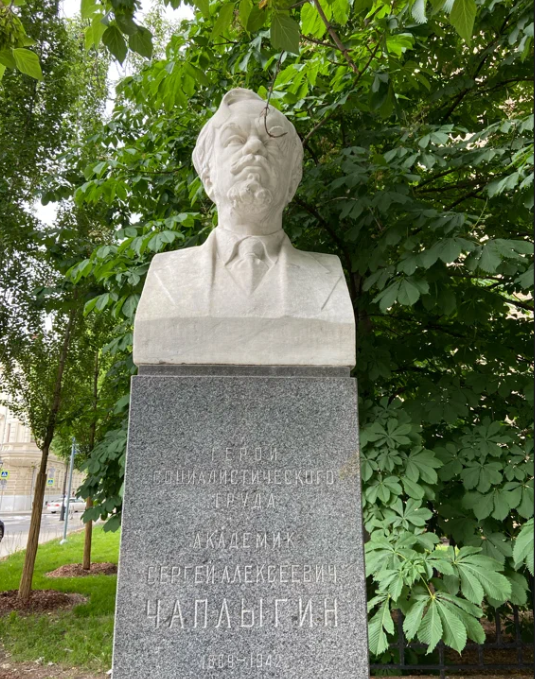Sergey Alekseevich
Chaplygin
1869-1942

Sergey Alekseevich Chaplygin was a Russian and Soviet scientist in the field of theoretical mechanics, mathematics, one of the founders of modern aeromechanics and aero and hydroaerodynamics, academician of the USSR Academy of Sciences (1929), Hero of Socialist Labor (1941), Honored Scientist of the RSFSR (1929), laureate of the Zhukovsky Prize (1925), awarded two Orders of Lenin (1933,1941), two Orders of the Red Banner of Labor (1928, 1932).He was born in the city of Ranenburg, now the city of Chaplygin, Ryazan region. The father of the future scientist served as a salesman in a shop. After his death in 1871, his mother and three children moved to Voronezh. After graduating from the Voronezh Gymnasium with a gold medal in 1886, he entered the Physics and Mathematics Faculty of Moscow University. During his studies, he begins his first scientific work on hydrodynamics “On the movement of heavy bodies in an incompressible fluid”. This study was presented in 1890 as a thesis. After a successful defense, on the recommendation of N.E. Zhukovsky, he was left at the university to prepare for a professorship. In 1894 he became a privatdozent of Moscow University. The first works of the scientist, created under the influence of N.E. Zhukovsky, belong to the field of hydromechanics. They describe the geometric interpretation of the laws of motion of solids in a liquid, discovered in a number of studies by Russian and foreign scientists. In 1898 he defended his master’s thesis with the scientific work “On some cases of motion of a solid body in a liquid”. In 1903 he defended his doctoral dissertation “On gas jets”, in which a method for studying jet movements of gas at any subsonic speeds was proposed. This work marked the beginning of a new branch of mechanics – gas dynamics, which later played a huge role in the development of aviation. From 1893 he taught physics at women’s secondary schools, at the Moscow Higher Technical School and the Moscow Engineering School. Since 1901 – Professor of mechanics at the Moscow Higher Women’s Courses, since 1903 – Professor at Moscow University in the Department of Applied Mathematics. In 1905-1918 – Director of the Moscow Higher Women’s courses. Since 1905, he was the director of the Moscow Higher Women’s Courses (MVZHK), and then the rector of the 2nd Moscow State University, into which these courses were transformed (in 1918-1919). In February 1911, Chaplygin left Moscow University together with a large group of professors in protest against the actions of the Minister of Education L.A. Kasso, who dismissed many progressive and leading professors and teachers at that time. In February 1911 Chaplygin left Moscow University together with a large group of professors in protest against the actions of the Minister of Education Kasso. During the Civil War, Professor Chaplygin worked in the Commission on Artillery Experiments at the Main Artillery Directorate of the Red Army (Kosartop) and at the Scientific Experimental Institute of Railways. In 1917-1922. He was again a professor at Moscow University, but left it to concentrate on scientific work. In 1918, the Central Aerohydrodynamic Institute (TsAGI) was organized in Moscow. S.A. Chaplygin was one of its leading researchers. In 1921, after the death of the founder and first head of TsAGI, N.E. Zhukovsky, Chaplygin became the chief scientific director and chairman of the TsAGI board (1921-1930). In 1928-1931 – Director (head) of TsAGI. In the 1930s, the scientist’s work became more applied. In 1931-1941. he led the creation of the largest aerohydrodynamic laboratories of TsAGI. In the early 30s, under the leadership of Chaplygin and his student M.V. Keldysh, research was conducted on the theory of flutter, which was later used in the design of high-speed aircraft. Since 1940, Academician Chaplygin has been chairman of the TSAGI Problem Commission on gas dynamics. Chaplygin’s works became the basis for solving problems about subsonic currents and allowed solving the main problems associated with the operation of the wing at high subsonic speeds, and other problems of modern aerodynamics. He solved a number of complex problems of aeromechanics and aviation, which greatly contributed to the development of the theory of stability of the aircraft wing in flight. For the first time, he derived formulas for unsteady wing movement – on takeoff and landing, which was of great importance for practical aerodynamics. For outstanding scientific achievements in 1926, S.A. Chaplygin was elected a corresponding member of the USSR Academy of Sciences, and on January 12, 1929 – Academician of the USSR Academy of Sciences. Since 1933 he was Chairman of the Group of equipment of the USSR Academy of Sciences, since 1937 – Chairman of the Commission on Hydromechanics and Aerodynamics of the USSR Academy of Sciences. With the outbreak of the Great Patriotic War in October 1941, S. A. Chaplygin moved to Novosibirsk, where part of the TsAGI laboratories was evacuated, which formed the TSAGI branch № 2, from which the Siberian Research Institute of Aviation (SibNIIA) subsequently grew.
Address: Moscow, Maly Kharitonyevsky Lane.

